Future Circular Lepton Collider Vibrational Crosstalk
Abstract
1. Introduction

2. Research Methodology
2.1. Transfer Functions
2.2. Finite Element Modeling
2.2.1. Domain Dimension
2.2.2. Boundary Conditions
2.2.3. Material Mechanical Properties
- The tunnel surrounded by 100% sandstone.
- The tunnel surrounded by 100% marl.
2.2.4. Mesh
2.2.5. Domain Size
2.2.6. Load Cases
3. Results and Discussion
3.1. The Transfer Functions of the Tunnel
3.2. The Vibrational Crosstalk Transfer Functions
4. Conclusions
Remarks
- The accuracy of the methodology for determining crosstalk was promising yet limited, as it assumed the mass of the Collider and Booster to be negligible compared to the effective mass of the tunnel. This discrepancy might affect the accuracy of the results.
- Due to geological uncertainty, the sensitivity of material properties may need further investigation.
- Further investigation into the rotational excitations of the Collider may be necessary, as they could potentially increase crosstalk vibration from the Booster to the Collider.
- The simulation could also be refined using 2.5D or 3D simulations of the tunnel to consider geometric damping more accurately.
Author Contributions
Funding
Data Availability Statement
Acknowledgments
Conflicts of Interest
Appendix A

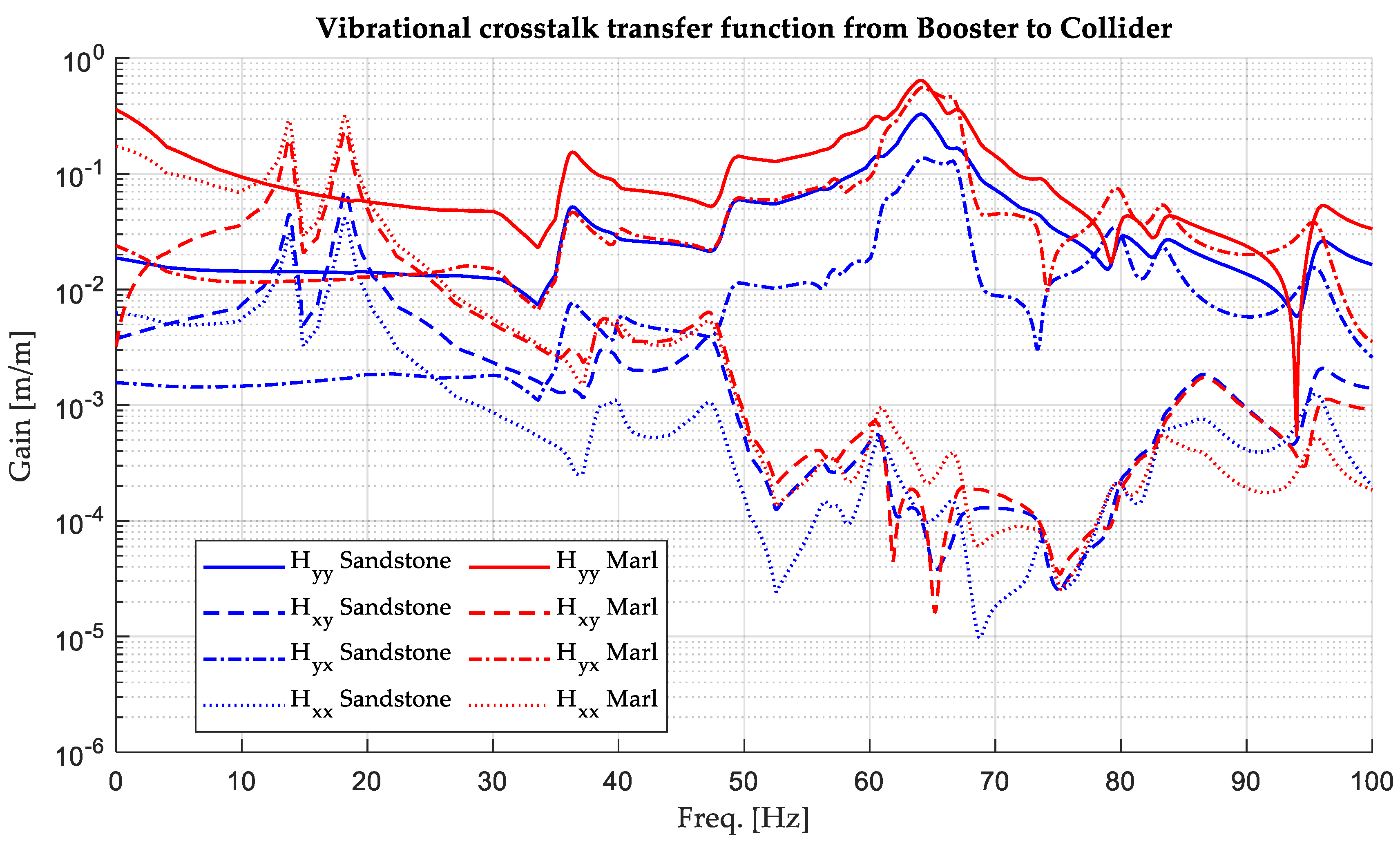
References
- Zimmermann, F.; Wilkinson, G.; Benedikt, M. FCC Week 2023. In Proceedings of the Future Circular Collider Conference, London, UK, 5–9 June 2023; Available online: https://indico.cern.ch/event/1202105/timetable/ (accessed on 26 August 2024).
- Aiba, M.; Goddard, B.; Oide, K.; Papaphilippou, Y.; Hernández, Á.S.; Shwartz, D.; White, S.; Zimmermann, F. Top-up injection schemes for future circular lepton collider. Nucl. Instrum. Methods Phys. Res. Sect. A Accel. Spectrometers Detect. Assoc. Equip. 2018, 880, 98–106. [Google Scholar] [CrossRef]
- Seryi, A. Ground Motion and Vibration Issues for Accelerators. In Proceedings of the 2001 Particle Accelerator Conference, Chicago, IL, USA, 18–22 June 2001; Available online: https://ieeexplore.ieee.org/document/987516/ (accessed on 26 August 2024).
- Schaumann, M.; Gamba, D.; Morales, H.G.; Corsini, R.; Guinchard, M.; Scislo, L.; Wenninger, J.; Schaumann, M. The effect of ground motion on the LHC and HL-LHC beam orbit. Nucl. Instrum. Methods Phys. Res. Sect. A Accel. Spectrometers Detect. Assoc. Equip. 2023, 1055, 168495. [Google Scholar] [CrossRef]
- Carra, F.; Baudin, L.; Artoos, K.; Atieh, S.; Bauche, J.; Bertarelli, A.; Bertinelli, F.; Brunner, O.; Capatina, O.; Chance, A.; et al. Deliverable 5.3: Arc Integration Concept and Arc-Cell Mock-Up. Available online: https://indico.cern.ch/event/1278881/contributions/5372483/attachments/2637434/4564315/FCC_Mid_term_report_5_3_Arc_integration.pdf (accessed on 26 August 2024).
- Valchkova-Georgieva, F. “INTEGRATION NEWS,” 2024. Available online: https://indico.cern.ch/event/1429624/contributions/6014070/attachments/2913347/5112102/FCC%2021.08.2024%20Integration_FV.pdf (accessed on 26 August 2024).
- Carra, F.; Baudin, L.; Bauche, J.; Artoos, K.; Atieh, S.; Bertarelli, A.; Brunner, O.; Capatina, O.; Chance, A.; Chemliet, S. FCC-ee Arc Half-Cell: Preliminary design & integration studies, with ideas for a mock-up. J. Phys. Conf. Ser. 2024, 2687, 022005. [Google Scholar]
- Carra, F.; Baudin, L.; Bauche, J.; Artoos, K.; Atieh, S.; Bertarelli, A.; Brunner, O.; Capatina, O.; Chance, A.; Chemli, S. First considerations on the supporting structures of FCC-ee booster and collider in the arc regions. J. Instrum. 2024, 19, T02008. [Google Scholar] [CrossRef]
- Hatzigeorgiou, G.D.; Beskos, D.E. Soil–structure interaction effects on seismic inelastic analysis of 3–D tunnels. Soil Dyn. Earthq. Eng. 2010, 30, 851–861. [Google Scholar] [CrossRef]
- Guo, J.; Xu, L.; Xu, C.; Chen, R.; Lin, J. Dynamic response analysis on stress and displacement of the shield tunnel structure and soil layer under train-induced vibration in Xiamen Metro Line 6. Sustainability 2022, 14, 11962. [Google Scholar] [CrossRef]
- Wang, F.; Shao, J.; Li, W.; Wang, L.; Wang, Y.; Liu, H. Numerical simulation study on lining damage of shield tunnel under train load. Sustainability 2022, 14, 14018. [Google Scholar] [CrossRef]
- Khan, M.A.; Sadique, M.R.; Harahap, I.H.; Zaid, M.; Alam, M.M. Static and dynamic analysis of the shielded tunnel in alluvium soil with 2D FEM model. Transp. Infrastruct. Geotechnol. 2022, 9, 73–100. [Google Scholar] [CrossRef]
- Sedarat, H.; Kozak, A.; Hashash, Y.M.; Shamsabadi, A.; Krimotat, A. Contact interface in seismic analysis of circular tunnels. Tunn. Undergr. Space Technol. 2009, 24, 482–490. [Google Scholar] [CrossRef]
- Yang, Y.; Liang, X.; Hung, H.-H.; Wu, Y. Comparative study of 2D and 2.5D responses of long underground tunnels to moving train loads. Soil Dyn. Earthq. Eng. 2017, 97, 86–100. [Google Scholar] [CrossRef]
- Lysmer, J.; Kuhlemeyer, R.L. Finite dynamic model for infinite media. J. Eng. Mech. Div. 1969, 95, 859–877. [Google Scholar] [CrossRef]
- ANSYS Inc. Mechanical APDL 2024 R2 Theory Reference. Available online: https://ansyshelp.ansys.com/public/account/secured?returnurl=/Views/Secured/corp/v242/en/ans_thry/ans_thry.html (accessed on 26 August 2024).
- Abada, A.; Abbrescia, M.; AbdusSalam, S.S.; Abdyukhanov, I.; Fernandez, J.A.; Abramov, A.; Aburaia, M.; Acar, A.O.; Adzic, P.R.; Agrawal, P.; et al. FCC-ee: The lepton collider: Future circular collider conceptual design report volume 2. Eur. Phys. J. Spec. Top. 2019, 228, 261–623. [Google Scholar] [CrossRef]
- Fern, E.J.; Di Murro, V.; Soga, K.; Li, Z.; Scibile, L.; Osborne, J.A. Geotechnical characterisation of a weak sedimentary rock mass at CERN, Geneva. Tunn. Undergr. Space Technol. 2018, 77, 249–260. [Google Scholar] [CrossRef]
- Eurocode 2. Design of Concrete Structures—Part 1-1: General Rules and Rules for Buildings; CEN National Members: Brusselss, Belgium, 2004.
- Gercek, H. Poisson′s ratio values for rocks. Int. J. Rock Mech. Min. Sci. 2007, 44, 1–13. [Google Scholar] [CrossRef]
- Haas, M.; Mongeard, L.; Ulrici, L.; D’Aloïa, L.; Cherrey, A.; Galler, R.; Benedikt, M. Applicability of excavated rock material: A European technical review implying opportunities for future tunnelling projects. J. Clean. Prod. 2021, 315, 128049. [Google Scholar] [CrossRef]
- Dassault Systems. Viscous Damping Ratios for Different Systems and Materials. Available online: https://help.solidworks.com/2022/english/SolidWorks/cworks/r_viscous_damping_ratios.htm (accessed on 26 August 2024).
- Strømmen, E.N. Structural Dynamics; Springer: Berlin/Heidelberg, Germany, 2014. [Google Scholar]
- Bedr, S.; Mezouar, N.; Verrucci, L.; Lanzo, G. Investigation on shear modulus and damping ratio of Algiers marls under cyclic and dynamic loading conditions. Bull. Eng. Geol. Environ. 2019, 78, 2473–2493. [Google Scholar] [CrossRef]
- Nishi, K.; Ishiguro, T.; Kudo, K. Dynamic properties of weathered sedimentary soft rocks. Soils Found. 1989, 29, 67–82. [Google Scholar] [CrossRef] [PubMed]
- Hoek, E.; Diederichs, M.S. Empirical estimation of rock mass modulus. Int. J. Rock Mech. Min. Sci. 2006, 43, 203–215. [Google Scholar] [CrossRef]
- Beskos, D.E.; Anagnostopoulos, S.A. Computer Analysis and Design of Earthquake Resistant Structures: A Handbook; WIT Press: Southampton, UK, 1997. [Google Scholar]
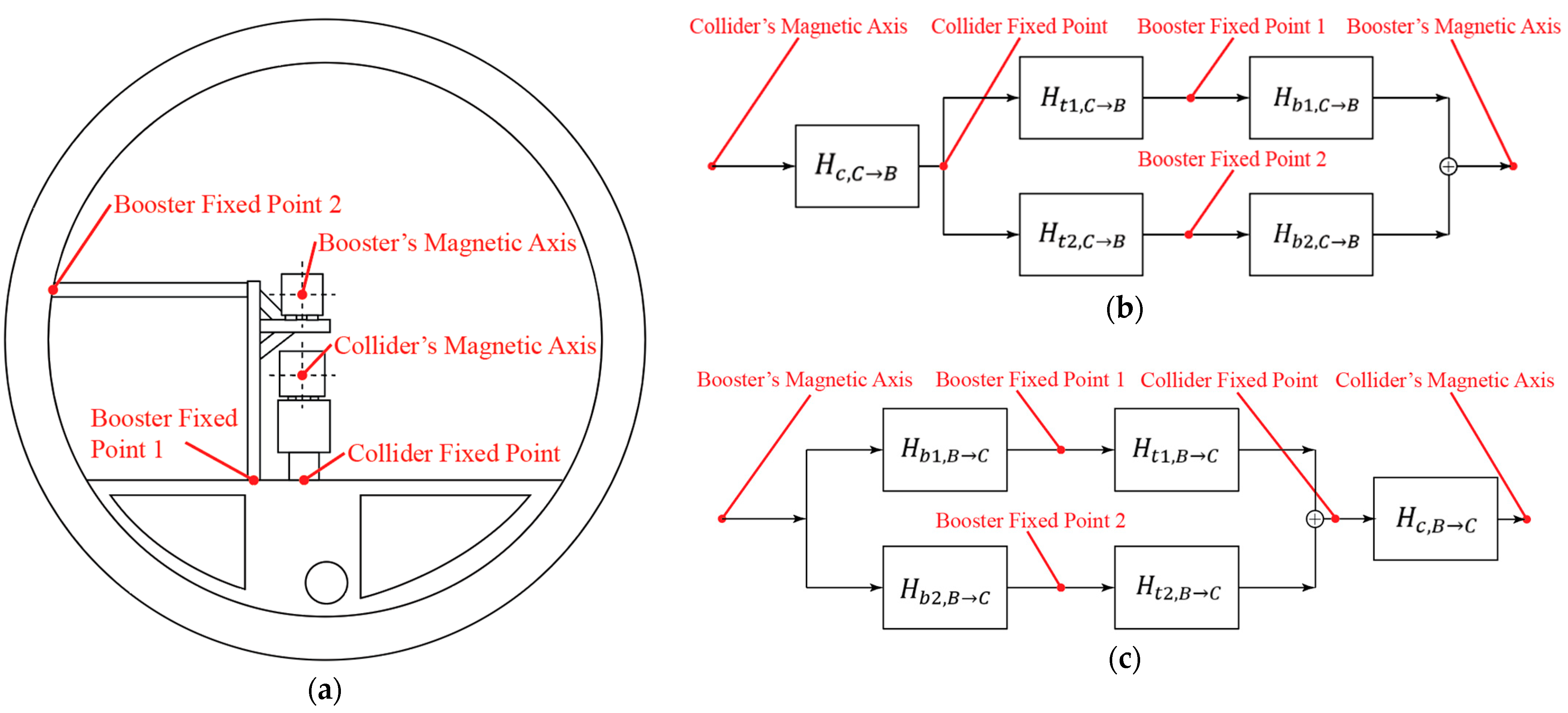

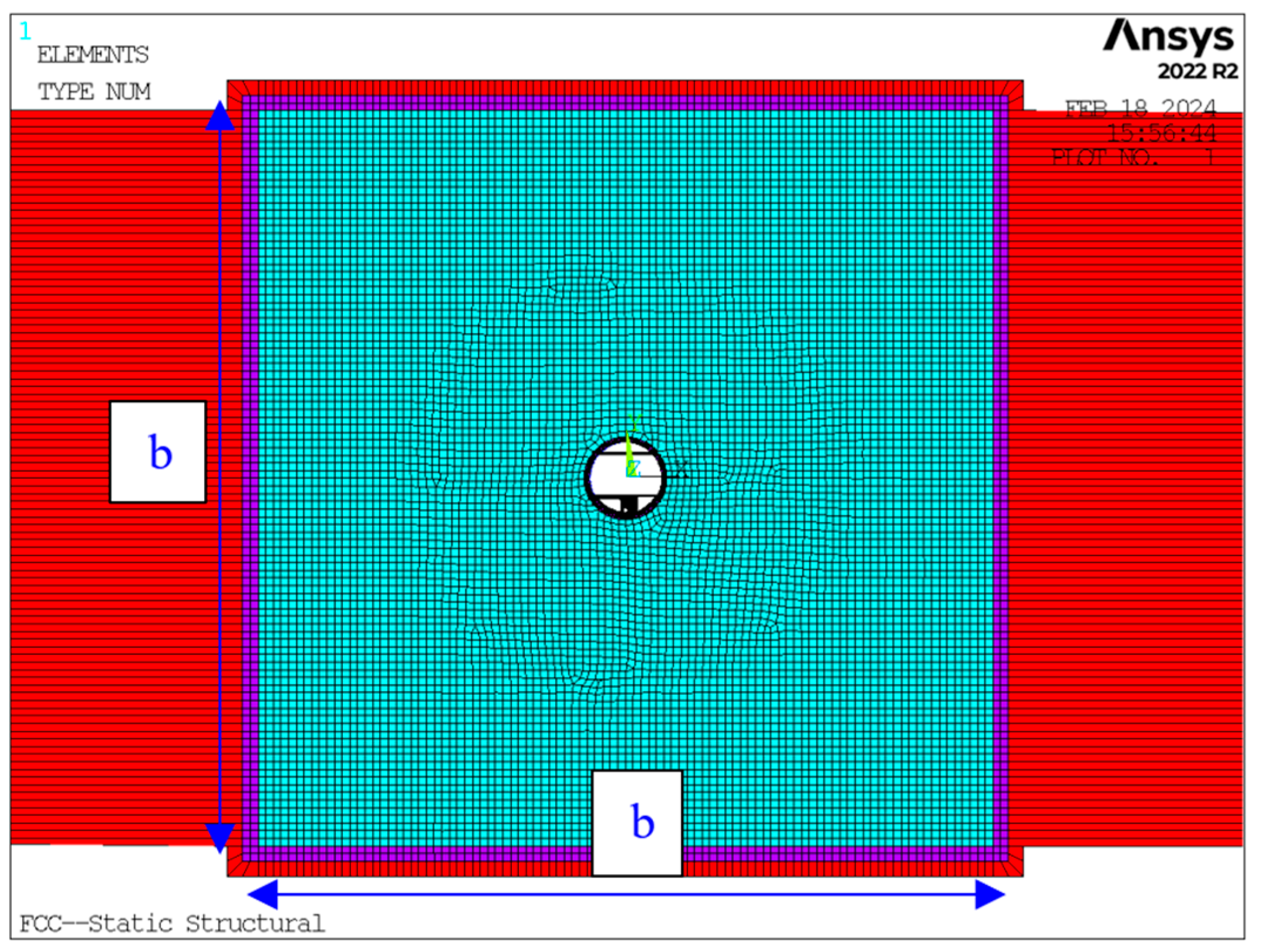
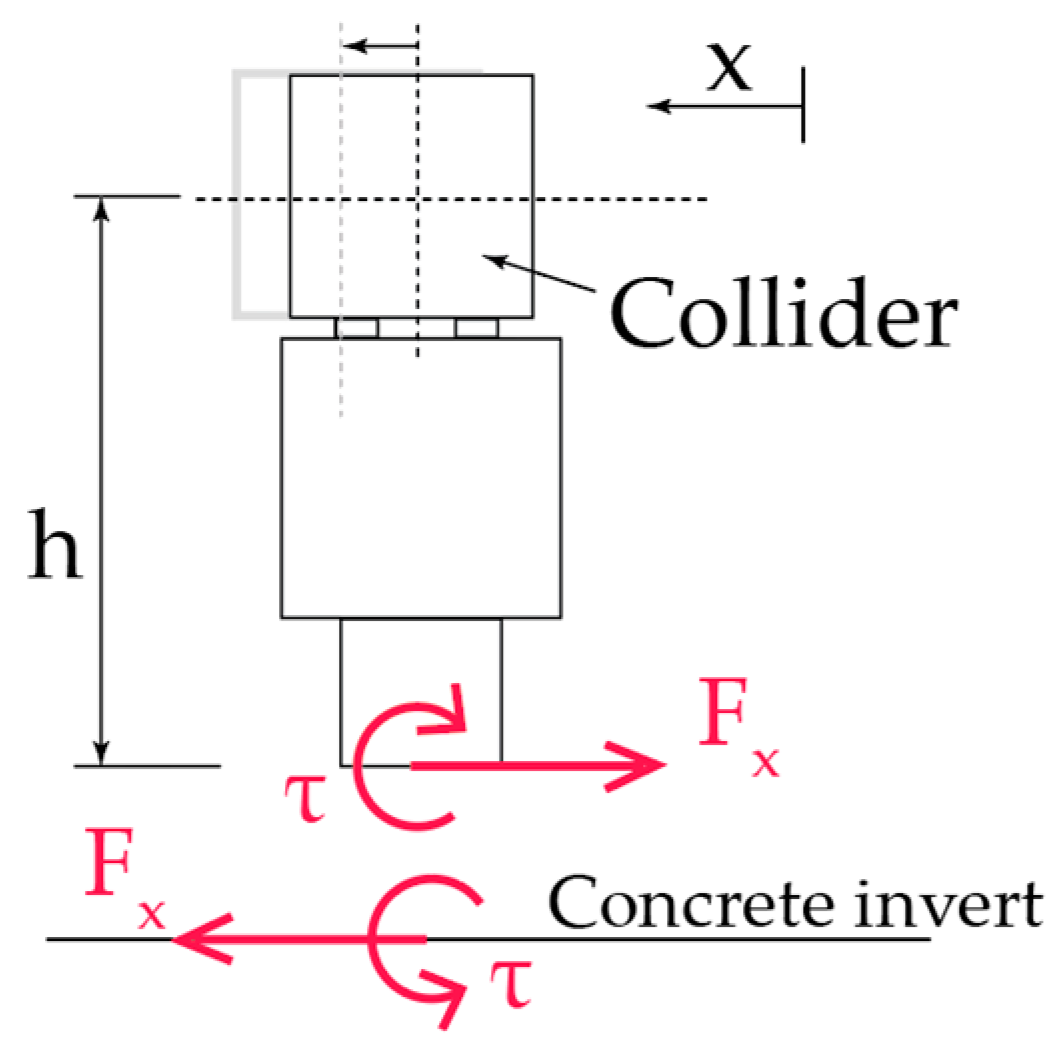
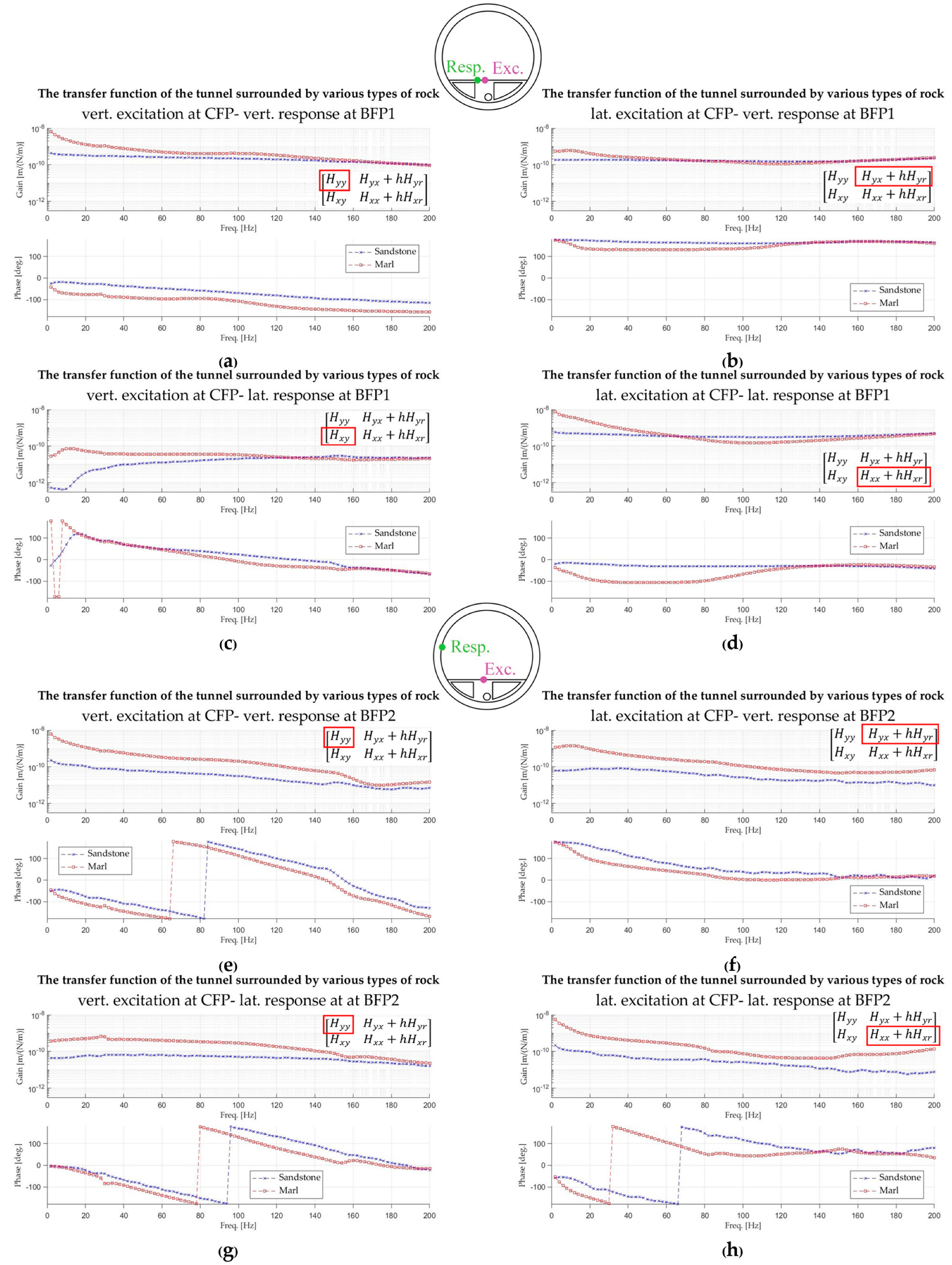

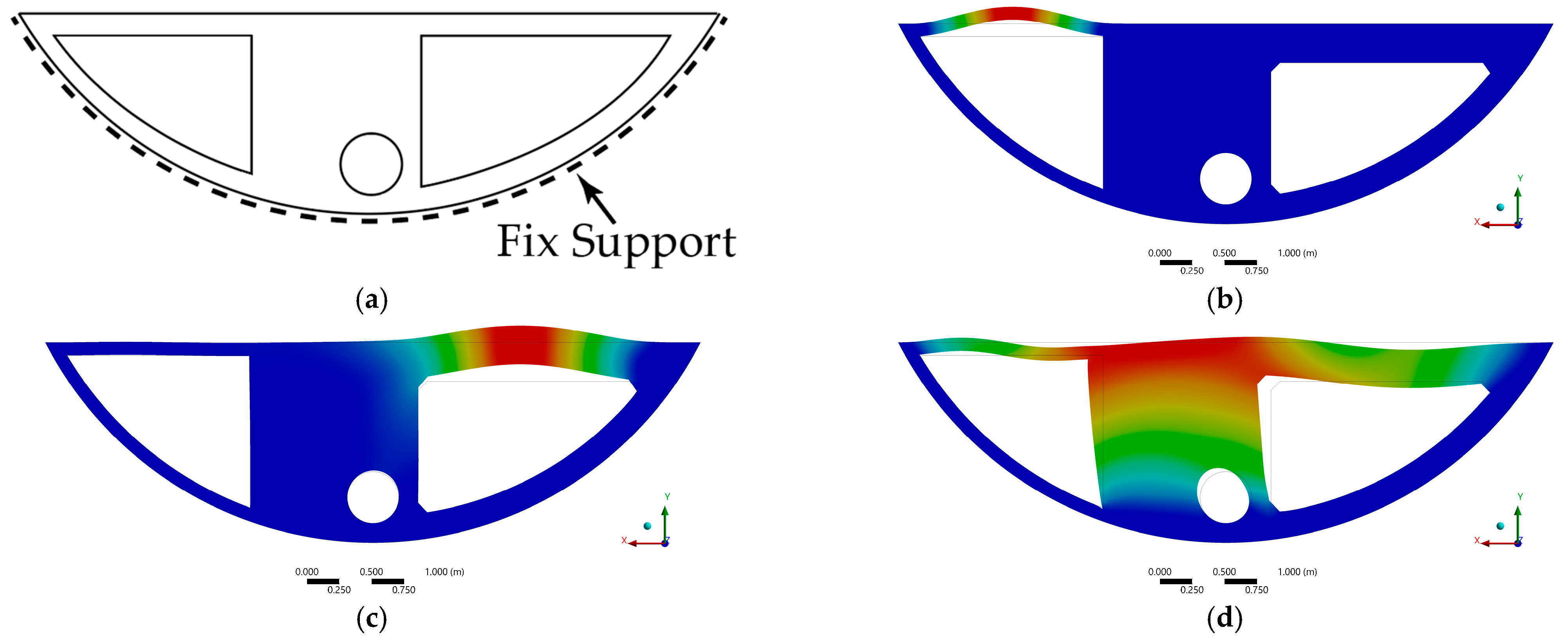
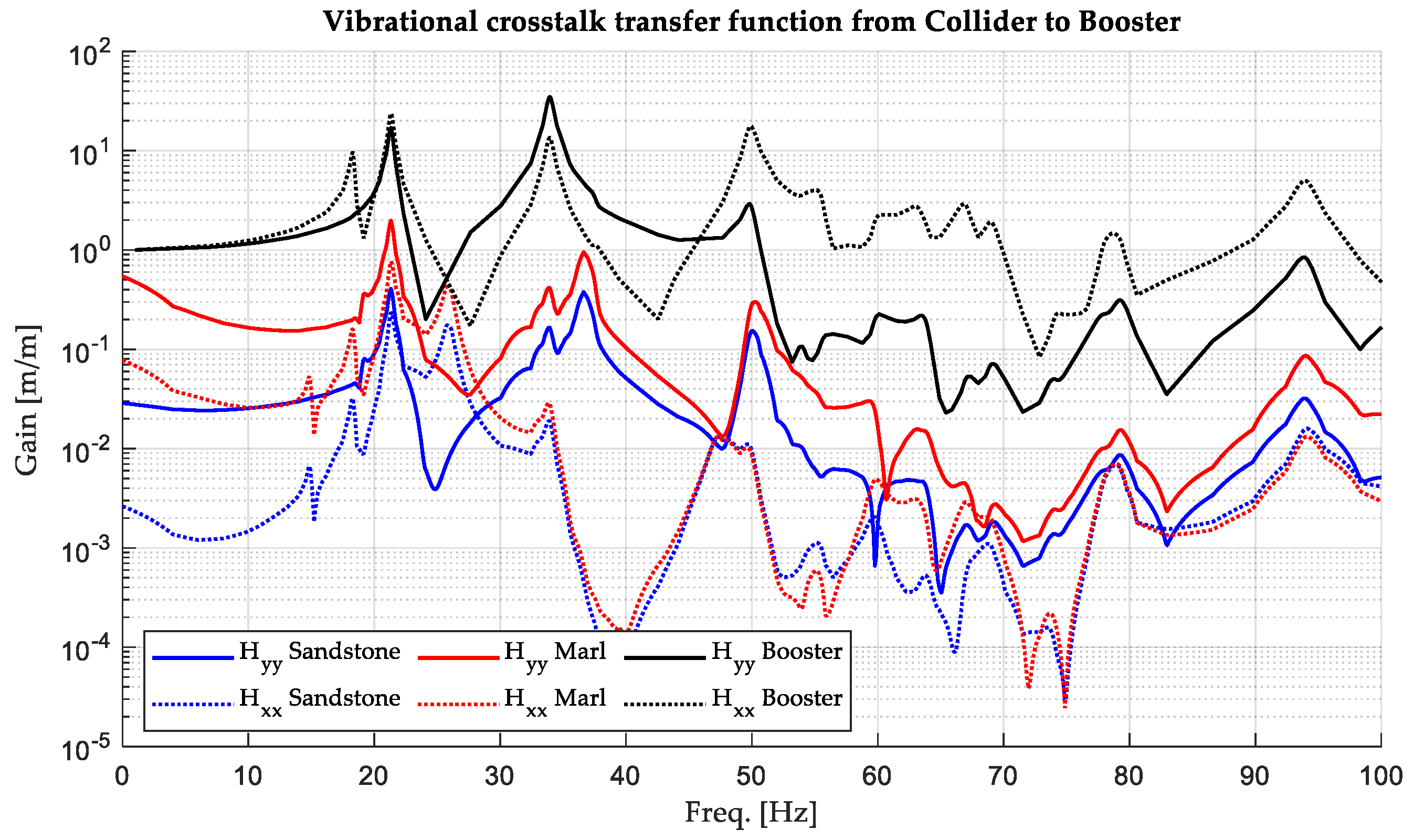

| Mechanical Properties | Marl | Sandstone | C20 Concrete |
|---|---|---|---|
| Density (kg/m3) | 2500 | 2560 | 2475 |
| Poisson’s ratio | 0.230 | 0.225 | 0.200 |
| Elastic Modulus (MPa) | 80 (rock mass) | 3400 (intact) | 30,000 |
| Material Damping Ratio | 1% | 1% | 3% |
| Research | Boundary Condition | The Ratio * |
|---|---|---|
| Hatzigeorgiou and Beskos (2010) [9] studied soil–structure interaction. | Unified viscous boundaries | 5.8 and 17.5 |
| Guo, Xu, et al. (2022) [10] studied the dynamic response of the tunnel and soil layer under the tunnel induced by the metro train. | Free Field boundary condition | 8.1 |
| Wang and Shao (2022) [11] conducted the numerical analysis to determine long-term structural damage from train load. | Viscous-spring boundary condition | 8.3 |
| Khan, Sadique, et al. (2022) [12] performed a dynamic analysis of the tunnel located in dry and saturated soil under seismic loading. | Standard absorbing boundary | 15 |
Disclaimer/Publisher’s Note: The statements, opinions and data contained in all publications are solely those of the individual author(s) and contributor(s) and not of MDPI and/or the editor(s). MDPI and/or the editor(s) disclaim responsibility for any injury to people or property resulting from any ideas, methods, instructions or products referred to in the content. |
© 2024 by the authors. Licensee MDPI, Basel, Switzerland. This article is an open access article distributed under the terms and conditions of the Creative Commons Attribution (CC BY) license (https://creativecommons.org/licenses/by/4.0/).
Share and Cite
Lersnimitthum, P.; Piccini, A.; Carra, F.; Boonyatee, T.; Wansophark, N.; Ajavakom, N. Future Circular Lepton Collider Vibrational Crosstalk. Vibration 2024, 7, 912-927. https://doi.org/10.3390/vibration7040048
Lersnimitthum P, Piccini A, Carra F, Boonyatee T, Wansophark N, Ajavakom N. Future Circular Lepton Collider Vibrational Crosstalk. Vibration. 2024; 7(4):912-927. https://doi.org/10.3390/vibration7040048
Chicago/Turabian StyleLersnimitthum, Purinut, Audrey Piccini, Federico Carra, Tirawat Boonyatee, Niphon Wansophark, and Nopdanai Ajavakom. 2024. "Future Circular Lepton Collider Vibrational Crosstalk" Vibration 7, no. 4: 912-927. https://doi.org/10.3390/vibration7040048
APA StyleLersnimitthum, P., Piccini, A., Carra, F., Boonyatee, T., Wansophark, N., & Ajavakom, N. (2024). Future Circular Lepton Collider Vibrational Crosstalk. Vibration, 7(4), 912-927. https://doi.org/10.3390/vibration7040048






